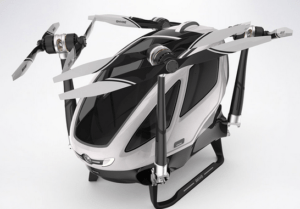 EHang, the Guangzhou, China based UAV manufacturer, has announced an agreement with Lung Biotechnology to provide them with a drone delivery service for manufactured organs for transplant. The fifteen-year agreement includes development and purchase of 1,000 units of the Manufactured Organ Transport Helicopter (MOTH) system, an evolved version of the EHang 184 intended to make manufactured organ delivery feasible. The collaboration stands to revolutionize the way organs are transported in the U.S., with the potential to save tens of thousands of lives.
EHang, the Guangzhou, China based UAV manufacturer, has announced an agreement with Lung Biotechnology to provide them with a drone delivery service for manufactured organs for transplant. The fifteen-year agreement includes development and purchase of 1,000 units of the Manufactured Organ Transport Helicopter (MOTH) system, an evolved version of the EHang 184 intended to make manufactured organ delivery feasible. The collaboration stands to revolutionize the way organs are transported in the U.S., with the potential to save tens of thousands of lives.
Lung Biotechnology manufactures lungs and other organs for transplant using a variety of technologies, including pig-to-human xenotransplantation, as well as regenerating them from stem cells. It plans to station the MOTH rotorcrafts outside of its organ manufacturing facilities, and use preprogrammed flight plans to hospitals and re-charging pads within the MOTH radius so that the manufactured organs can be delivered within their post-production window of viability. This huge shift in organ production and delivery has the potential to save tens of thousands of lives. Currently, organ transplants are limited by the number of brain-dead donors, which results in thousands of deaths on organ transplant waiting lists each year. In the case of lung transplants, only about 2,000 lung procedures are performed annually, whereas over 200,000 people in the U.S. die of end-stage lung disease each year. The prospect of manufactured lungs could eliminate this numerical limit, and delivering them autonomously via the all-electric MOTH technology will save the healthcare system many millions of dollars with a dramatically reduced carbon footprint. MOTH purchases by Lung Biotechnology will be contingent upon successful development and U.S. Federal Aviation Administration approval of the MOTH rotorcraft, as well as approval by the U.S. Food and Drug Administration of Lung Biotechnology’s xenotransplantation organ products.
“The well-known locations of transplant hospitals and future organ manufacturing facilities makes the EHang technology ideal for Highway-In-The-Sky (HITS) and Low-Level IFR Route (LLIR) programs,” said Martine Rothblatt, Ph.D., Chairman and CEO of Lung Biotechnology. “We anticipate delivering hundreds of organs a day, which means that the MOTH system will help save not only tens of thousands of lives, but also many millions of gallons of aviation transport gasoline annually.”
The 184 is an autonomous drone capable of carrying a passenger more than 10 miles through the air at speeds up to 65 miles per hour simply by entering a destination into its accompanying smartphone app. Company officials maintain that it is perfectly suited for a variety of medical emergency transport. After several years of development, EHang unveiled the world’s first autonomous aerial vehicle at CES 2016 to great acclaim.
“This is exactly the kind of global impact we envisioned when building the 184,” explained Huazhi Hu, CEO of EHang. “Partnering with Martine and Lung Biotechnology is an incredible opportunity to bring the 184 to the emergency medical space, and specifically help to revolutionize the organ delivery system in the U.S. It’s also representative of our broader dedication to making the EHang 184 and its commercial drones readily available to a number of different industries today.”
Frank Schroth is editor in chief of DroneLife, the authoritative source for news and analysis on the drone industry: it’s people, products, trends, and events.
Email Frank
TWITTER:@fschroth







Leave a Reply